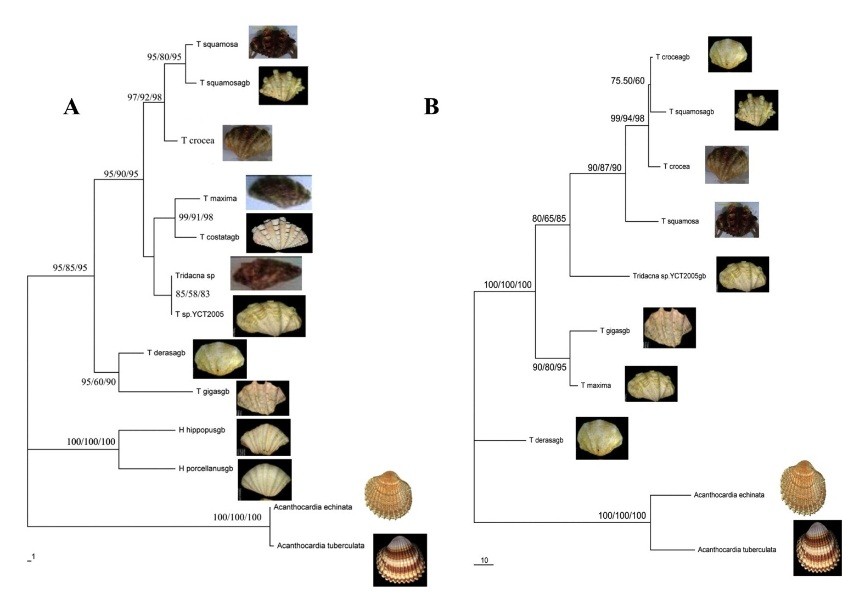 Giant clams (Tridanidae) are one of the high value marine mollusks in Vietnam. A total of 4 species were collected along Vietnamese coast (Vân Phong Bay and Con Dao Island). Bayesian Inference, Maximum Parsimony and Maximum Likelihood tree were constructed based on different mitochondrial genetic molecular marker, 16S and CO1 mtDNA gene from T. crocea, T. squamosa, T. maxima, Tridacna sp., and several sequences derived from Genbank. The results from 16S mtDNA showed that giant clams formed 2 monophyletic groups following genus Hippopus and Tridacna. Within Tridacna group, T. crocea was more closely related to T. squamosa than to T. maxima. .T. maxima was closed to T. costata and Tridacna spYCY2005. T. gigas was clustered to T. derasa. T. crocea and T. squamosa were sister taxa and sister group to T. maxima and T. costata. They together formed a sister clade to T. gigas and T. derasa. Two species of genus Hippopus (H. hippopus và H. porcellanus) clustered together with high bootstrap support. The analysis based on CO1 mtDNA showed the relationships as ((T. squamosa+T. crocea) (Tridacna sp.)) (T. maxima+T. gigas). T. derasa has undetermined taxonomic position.
Giant clams (Tridanidae) are one of the high value marine mollusks in Vietnam. A total of 4 species were collected along Vietnamese coast (Vân Phong Bay and Con Dao Island). Bayesian Inference, Maximum Parsimony and Maximum Likelihood tree were constructed based on different mitochondrial genetic molecular marker, 16S and CO1 mtDNA gene from T. crocea, T. squamosa, T. maxima, Tridacna sp., and several sequences derived from Genbank. The results from 16S mtDNA showed that giant clams formed 2 monophyletic groups following genus Hippopus and Tridacna. Within Tridacna group, T. crocea was more closely related to T. squamosa than to T. maxima. .T. maxima was closed to T. costata and Tridacna spYCY2005. T. gigas was clustered to T. derasa. T. crocea and T. squamosa were sister taxa and sister group to T. maxima and T. costata. They together formed a sister clade to T. gigas and T. derasa. Two species of genus Hippopus (H. hippopus và H. porcellanus) clustered together with high bootstrap support. The analysis based on CO1 mtDNA showed the relationships as ((T. squamosa+T. crocea) (Tridacna sp.)) (T. maxima+T. gigas). T. derasa has undetermined taxonomic position.
Phylogenetic relationship of giant clams (Tridacna spp.) collected in the South and Central coast of Vietnam
Related
- Phylogeny of zoonotic parasites in fresh and brackish water fish in Vietnam (21-7-2014 12:12:31)
- Isolation, identification of luminous Vibrio in diseased cultured common seahorse (Hippocampus kuda) (04-8-2014 02:03:24)
- Feeding mode of cone snail (Conus spp.) and phylogenetic relationships (04-8-2014 01:59:46)
- Identification of cone snail (Conus spp.) in the coastal Central Southern Vietnam based on morophologic and gennetic chacracters (04-8-2014 01:57:34)
Others
- About us (17-7-2014 09:35:40)
- SVM30022GR0249 "Management and restoration mangrove forests in the north of Khanh Hoa province - Toward sustainable landscape" (25-10-2023 09:44:51)
- VINIF.2022.DA00021 "DNA metabarcoding and integrated information database - Implication for Ichthyoplankton survey and fisheries management in Vietnam" (25-10-2023 09:53:54)
- Riverscape Genetics to Inform Natural History of Exploited Fishes in the Lower Mekong River Basin (23-10-2017 11:43:14)
